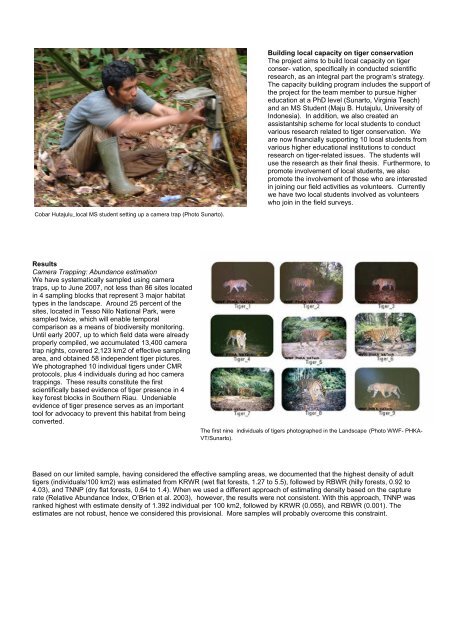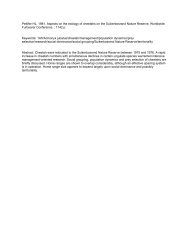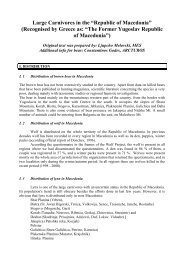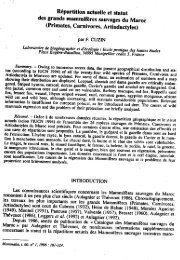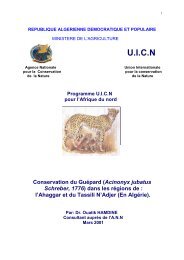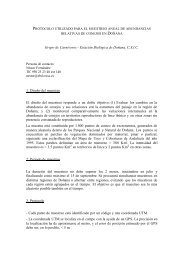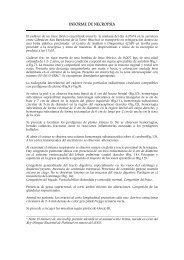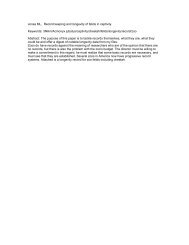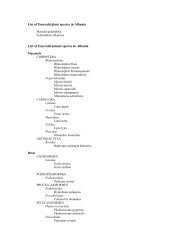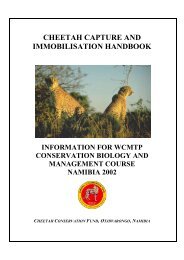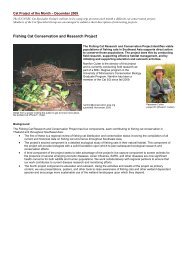Research-based Sumatran Tiger Conservation in a Multi-use ...
Research-based Sumatran Tiger Conservation in a Multi-use ...
Research-based Sumatran Tiger Conservation in a Multi-use ...
You also want an ePaper? Increase the reach of your titles
YUMPU automatically turns print PDFs into web optimized ePapers that Google loves.
Cobar Hutajulu_local MS student sett<strong>in</strong>g up a camera trap (Photo Sunarto).<br />
Results<br />
Camera Trapp<strong>in</strong>g: Abundance estimation<br />
We have systematically sampled us<strong>in</strong>g camera<br />
traps, up to June 2007, not less than 86 sites located<br />
<strong>in</strong> 4 sampl<strong>in</strong>g blocks that represent 3 major habitat<br />
types <strong>in</strong> the landscape. Around 25 percent of the<br />
sites, located <strong>in</strong> Tesso Nilo National Park, were<br />
sampled twice, which will enable temporal<br />
comparison as a means of biodiversity monitor<strong>in</strong>g.<br />
Until early 2007, up to which field data were already<br />
properly compiled, we accumulated 13,400 camera<br />
trap nights, covered 2,123 km2 of effective sampl<strong>in</strong>g<br />
area, and obta<strong>in</strong>ed 58 <strong>in</strong>dependent tiger pictures.<br />
We photographed 10 <strong>in</strong>dividual tigers under CMR<br />
protocols, plus 4 <strong>in</strong>dividuals dur<strong>in</strong>g ad hoc camera<br />
trapp<strong>in</strong>gs. These results constitute the first<br />
scientifically <strong>based</strong> evidence of tiger presence <strong>in</strong> 4<br />
key forest blocks <strong>in</strong> Southern Riau. Undeniable<br />
evidence of tiger presence serves as an important<br />
tool for advocacy to prevent this habitat from be<strong>in</strong>g<br />
converted.<br />
Build<strong>in</strong>g local capacity on tiger conservation<br />
The project aims to build local capacity on tiger<br />
conser- vation, specifically <strong>in</strong> conducted scientific<br />
research, as an <strong>in</strong>tegral part the program’s strategy.<br />
The capacity build<strong>in</strong>g program <strong>in</strong>cludes the support of<br />
the project for the team member to pursue higher<br />
education at a PhD level (Sunarto, Virg<strong>in</strong>ia Teach)<br />
and an MS Student (Maju B. Hutajulu, University of<br />
Indonesia). In addition, we also created an<br />
assistantship scheme for local students to conduct<br />
various research related to tiger conservation. We<br />
are now f<strong>in</strong>ancially support<strong>in</strong>g 10 local students from<br />
various higher educational <strong>in</strong>stitutions to conduct<br />
research on tiger-related issues. The students will<br />
<strong>use</strong> the research as their f<strong>in</strong>al thesis. Furthermore, to<br />
promote <strong>in</strong>volvement of local students, we also<br />
promote the <strong>in</strong>volvement of those who are <strong>in</strong>terested<br />
<strong>in</strong> jo<strong>in</strong><strong>in</strong>g our field activities as volunteers. Currently<br />
we have two local students <strong>in</strong>volved as volunteers<br />
who jo<strong>in</strong> <strong>in</strong> the field surveys.<br />
The first n<strong>in</strong>e <strong>in</strong>dividuals of tigers photographed <strong>in</strong> the Landscape (Photo WWF- PHKA-<br />
VT/Sunarto).<br />
Based on our limited sample, hav<strong>in</strong>g considered the effective sampl<strong>in</strong>g areas, we documented that the highest density of adult<br />
tigers (<strong>in</strong>dividuals/100 km2) was estimated from KRWR (wet flat forests, 1.27 to 5.5), followed by RBWR (hilly forests, 0.92 to<br />
4.03), and TNNP (dry flat forests, 0.64 to 1.4). When we <strong>use</strong>d a different approach of estimat<strong>in</strong>g density <strong>based</strong> on the capture<br />
rate (Relative Abundance Index, O’Brien et al. 2003), however, the results were not consistent. With this approach, TNNP was<br />
ranked highest with estimate density of 1.392 <strong>in</strong>dividual per 100 km2, followed by KRWR (0.055), and RBWR (0.001). The<br />
estimates are not robust, hence we considered this provisional. More samples will probably overcome this constra<strong>in</strong>t.


